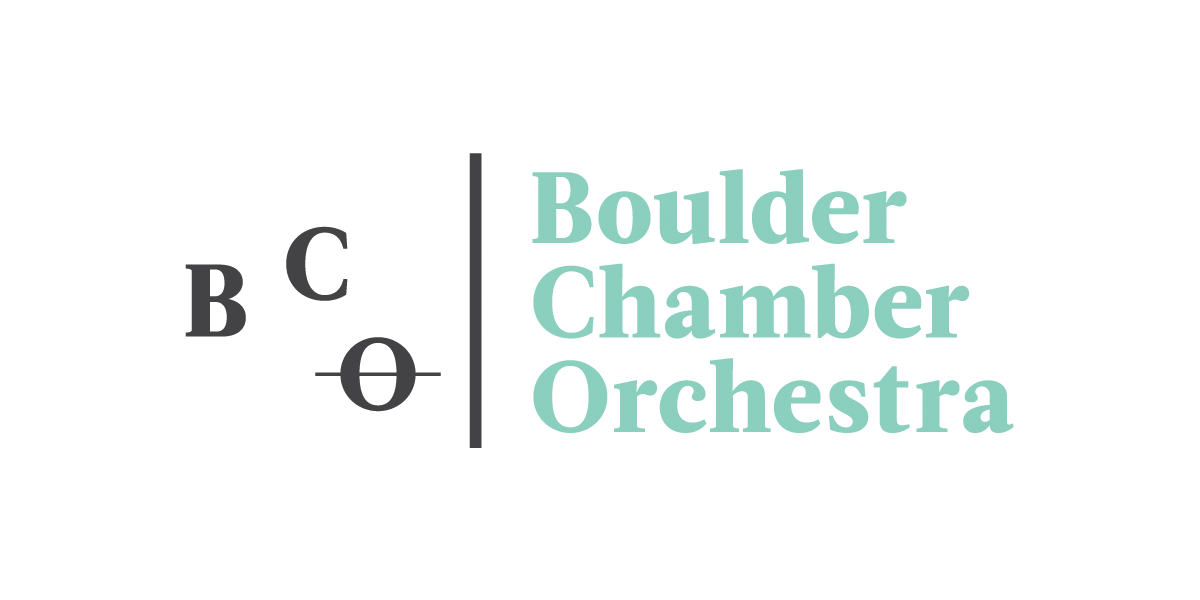BOULDER CHAMBER ORCHESTRA
“VIRTUOSITY!”
SATURDAY, MARCH 2, 2024 | 7:30 PM | BOULDER ADVENTIST CHURCH
BAHMAN SALESS
MUSIC DIRECTOR
RICHARD O’NEIL
VIOLA
VALSE TRISTE, OP. 18 (1901/1902) OSCAR NEDBAL
(1874 – 1930)
VIOLA CONCERTO IN G MAJOR, TWV 51:G9 (C. 1716–21) G.P. TELEMANN
I. LARGE (1681 – 1767)
II. ALLEGRO
III. ANDANTE
IV. PRESTO
GRAND TANGO FOR VIOLA AND ORCHESTRA (1982) ASTOR PIAZZOLA
(1921 – 1992)
– INTERMISSION –
GROSSE FUGUE, OP. 133 (1825) LUDWIG VAN BEETHOVEN
(1770 – 1827)
OSKAR NEDBAL: VALSE TRISTE
Oskar Nedbal (1874-1930) was born in the Czech town of Tabor. He studied violin and composition, the latter with Dvorak, at the Prague Conservatory. A fine violinist, he was a founding member of the famous Bohemian String Quartet and also served as conductor of the Prague Philharmonic for over a decade.
His famous Valse Triste comes from his ballet suite Pohadka o Honzov (Tale of Honza) more commonly known in English as the Tale of Simple Johnny. The ballet suite was composed in 1902 for orchestra. However, Nedbal on the recommendation of his fellow quartet players decided to make an arrangement for string quartet. This was done in 1907 and ever since it has become a popular encore piece. The two string quartet ensembles which originally premiered and popularized it were Nedbal's own Bohemian Quartet and the Ševčík-Lhotský String Quartet, named after the famous Czech violin soloist and very influential teacher Otakar Ševčík. (Lhotský and the other players had all studied with Ševčík). Surprisingly, we have only been able to find one recording of the work in the quartet arrangement. It is by the famous Ševčík-Lhotský String Quartet some time around WWI. As a result the sound quality is not up to modern standards and the playing of Lhotsky with its portamento style is of yesteryear and no longer in vogue. (Program Notes by Edition Silvertrust)
G. P. TELEMANN: VIOLA CONCERTO IN G MAJOR
Georg Phillipp Telemann was born at Magdeburg, Germany on 14 March 1681 and died in Hamburg, Germany on 25 June 1767. According to Wolfgang Hirschmann in his Preface to the Bärenreiter score (2002), this work probably originated between 1716 and 1721 while Telemann was in Frankfurt. This concerto was first published in 1731. It is interesting to note that the concerto went out of print for over two centuries until it was brought out in a Bärenreiter edition prepared by Hellmuth Christian Wolff in 1941. The score calls for solo viola, strings, and basso continuo. This evening’s performance utilizes a piano reduction prepared by Wolfgang Hirschmann.
Telemann was the most prolific composer of his time and was widely regarded as Germany’s leading composer during the first half of the 18th century. Telemann enjoyed much more popularity than his contemporary J. S. Bach. Many of Telemann’s compositions feature a prominent use of the viola. Along with chamber works such as the trio sonatas that have a significant solo viola part, Telemann also wrote a Concerto in G major for two violas and a Concerto in A major for two violins, viola and continuo. The Twelve Fantasias, originally written for violin, have been transcribed for the viola and are frequently performed. Maurice W. Riley, in his groundbreaking treatise The History of the Viola,states that “[t]he fact that Telemann was a champion of the viola was well known to his contemporaries, as was substantiated by Johann Philipp Eisel, who pointed out in 1738 that the viola was not only used for filling in the middle harmonies, but also as a solo instrument in the ‘concertos and concert overtures of the famous Kapellmeister Telemann’.” Hirschmann states that Telemann may have written the viola concerto for his own use, as “Telemann’s masterly treatment of the viola in this concerto becomes understandable when we bear in mind that his principal instrument was the violin and that he constantly strove to play every instrument he wrote for. There can be no question that he had a deep understanding of the viola from his own experience and practice.”
This work consists of four movements in the classic sonata da chiesa pattern typical of many of Telemann’s concerti, in which the movements alternate slow-fast-slow-fast. All four movements are also related to Italian ritornello form, which is characterized by the orchestra or piano stating thematic material and the solo part responding to that statement with its own material (usually similar but sometimes different). The opening Largo is characterized by a stately theme utilizing a sarabande rhythm. The second movement Allegro features a jaunty arpeggiated theme which is constantly traded off and developed by both solo and tutti parts. The third movement Andante is the only movement of the four in a minor key and is also characterized by the solo line replying to the opening ritornello with different thematic material. The closing Presto returns us to G major and also to an exchange between solo and tutti part similar to that in the first and second movements. (Program Notes by Dr. Daniel Doña)
A. PIAZZOLA: PIANO TRIO IN C MINOR, OP. 101
Astor Piazzola was born at Mar del Plata, Argentina on 11 March 1921 and died in Buenos Aires on 5 July 1992. He wrote Le Grand Tango, originally scored for cello and piano, in the summer of 1981 while he was at his summer home, the Chalet El Caso, in Uruguay. The piece was dedicated to the great cellist Mstislav Rostropovich. The version for viola and piano, approved by the composer, was arranged by the violist Tomás Tichauer and pianist Mónica Cossachov.
After Le Grand Tango was written, it took a few years for the piece to be performed: when Rostropovich received the score from Piazzola he put it aside for several years as he had not heard of the composer at the time. It was not until April 1990 that the esteemed cellist came to Argentina to coach the piece with the composer as well as share some suggested revisions to make the piece more idiomatic for the instrument. In their biography of Piazzola, also entitled Le Grand Tango, Maria Susana Azzi and Simon Collier recount that initial session:
Rostropovich, having looked at the music, and “astounded by the great talent of Astor,” decided he would include it in a concert. He made some changes in the cello part and wanted Piazzolla to hear them before he played the piece. Accordingly, in April 1990, he rehearsed it with Argentine pianist Susana Mendelievich in a room at the Teatro Colón, and Piazzolla gently coached the maestro in tango style–“Yes, tan-go, tan-go, tan-go.” The two men took an instant liking to one another. It was, says Mendelievich, “as if Rostropovich had played tangos all his life.”
The piece is written in ternary form, with two fast outer sections and a slow middle section. It is a classic example of what some call Piazzolla’s “nuevo tango” style, exhibiting fugue, extreme chromaticism, dissonance, and elements of jazz. Piazzolla’s style was met with resistance from the old-guard, but by the 1980s his music was widely accepted both internationally and in his home country, where he was seen as the savior of the tango. (Program notes by Dr. Daniel Doña)
L. VAN BEETHOVEN: GROSSE FUGUE, OP. 133
In 1822, Beethoven wrote, “I feel I am on the threshold of great things.” As it turned out, he was correct.
It had been twelve years since his last quartet, the Op.95 “Serioso” when Beethoven received a commission for “one, two or three string quartets” from Prince Nikolas Galitzen, an amateur cellist and longtime advocate of Beethoven’s work. With the Ninth Symphony and Missa Solemnis finally completed in 1823, an exhausted Beethoven took two months off before beginning work on his final string quartets. He completed the Op.127 quartet in February of 1825, the Op. 132 quartet in July, and Op. 130 in November of the same year. Prince Galitzen received his three new quartets in mid-1826, and proceeded to never pay Beethoven for the works. The Schuppanzigh Quartet, a group that championed many of Beethoven’s most challenging new works, premiered the Op.130 quartet on the evening of March 21, 1826. Beethoven, by this point a recluse and extremely uncomfortable at high profile social events, spent the evening of the premiere in a café waiting for news of the audience and critic response. The six-movement quartet was received well, with the exception of the giant fugal last movement, which overwhelmed the audience.
At the urging of his friends and publisher, Beethoven reluctantly agreed to write a new concluding movement for the Op.130 quartet in the hopes that the work as a whole would be more readily accepted. Beethoven completed the new finale for Op.130 in November of 1826, and the giant fugal last movement, or Grosse Fuge, was published as a freestanding composition, and given the catalog number of Op.133.
The Grosse Fuge begins with a thirty measure Overtura where Beethoven presents the fugal subject of the movement in four different versions, which he uses as the foundation for the entire movement. After an initial unison chord, Beethoven offers four quick glimpses of the jagged primary fugal subject in four differing forms: the first, a heavy statement played together by all four instruments; the second, a quick and syncopated version; the third, a softer more lyrical statement; and the fourth, a tentative line sung by the solo first violin.
The main body of the fugue then begins with the first violin playing an angular second theme against the viola’s presentation of the primary fugal subject from the Overtura. With these two musical ideas, Beethoven builds a complex double fugue full of unexpected dissonance and dense rhythmic combinations. Within the movement, there are two slower and softer sections of music, both built on variations of the fugal subject, that offer momentary respites from the rigors of the body of the movement. The coda is announced with a loud unison statement of the fugal subject, and the movement then comes to a swift and decisive conclusion.
The Grosse Fuge remains today one of the most monumental single movements of music in the history of western music. Its contemporary sound and robust character continue to challenge listeners, and it reveals to us the complex psychology of Beethoven at the height of his compositional prowess and social reclusion. Igor Stravinsky, one the greatest artistic innovators of the twentieth century said of Beethoven’s Grosse Fuge: “this absolutely contemporary piece of music will remain contemporary forever. . . I love it beyond any other.” (Program notes by Kurt Baldwin)
Tonight’s Roster (alphabetical Order)
Violins:
Annamaria Karacson (Concert Master)
Daniel Colbert
Rinat Erlichman
Jordan Grantonic
Caitlin Jacobsen
Anna Lugbill
Brune Macary (Principal 2nd)
Kina OnoA
Ava Pacheco
Yenlik Weiss (Assistant Concertmaster)
Sarah Whitnah (Assistant Principal 2nd)
Alexi Whitsel
Violas
Aniel Caban (Principal)
Aimee McAnulty
Stephanie Mientka
Brightin Schlumpf
James Shaw (Assistant Principal)
Celli
Joey Howe (Principal Cello)
Chas Barnard
Andrew Brown (Assistant Principal)
Peyton Magalhaes
Bass
Kevin Sylves (Principal Bass)
Keyboard
Madoka Asari






